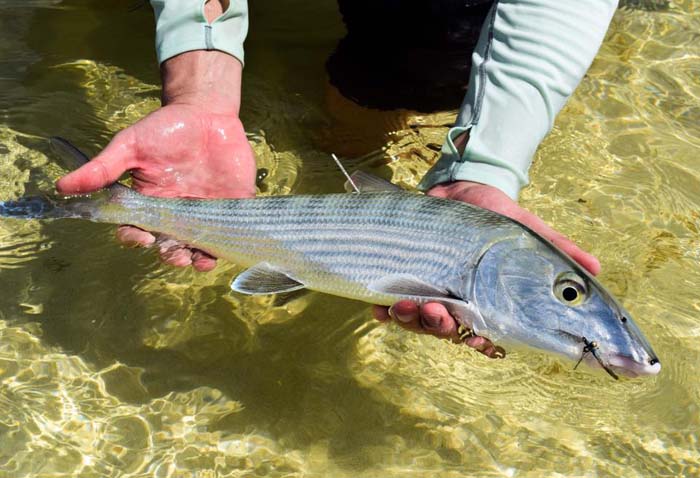
This bonefish was just tagged, fin clipped and released in the Bahamas! We get very valuable information on bonefish habitat use from bonefish tagging. It has been instrumental in showing the value of spawning locations and other habitat to bonefish, as we have recorded them traveling long distances to spawn. BTT image.
Bonefish & Tarpon Trust Quarterly Letter from the Chairman of the Board, Harold Brewer

Harold Brewer.
[dropcap]C[/dropcap]ome spring, anglers are on the move. Some travel to exotic locales to fish remote bonefish flats in the Caribbean, while others head down to the Yucatán Peninsula, hoping to find cooperative permit. Many travel locally, moving up and down the Florida Keys like the migrating tarpon they pursue. Recent studies by BTT and other partnering research organizations have shown that many of the places we enjoy fishing are in fact connected—not only by way of migration, but also through shared spawning locations, larval transport via ocean currents, and the exchange of data shared among anglers and researchers across state and international boundaries.
In an unprecedented effort by citizen scientists, fishing guides and researchers, over 23,000 tarpon scales were collected and analyzed for our Tarpon Genetics Program. The data shows that there is a single genetic population of Atlantic Tarpon that we all share, no matter the habitat or spawning locations. Tarpon’s remarkable ability to migrate vast distances to spawning sites shared by fish from different areas, combined with the transport of the resulting larvae to a variety of different inshore locations, contribute to the high level of genetic mixing.
Our Tarpon Acoustic Tagging Project, a wide-reaching study that has tagged well over 50 fish to date across Florida, Georgia and South Carolina, underscores the need for cohesive conservation approaches that transcend state and federal borders. Some fish have exhibited north-south movements, traveling from the Keys to Apalachicola, FL or farther north. In consecutive years, we have observed one 55-pound fish migrate from the Lower Keys up to North Carolina and the Chesapeake Bay—this tarpon swam an average of 20 miles per day for 52 days straight. Conversely, some tarpon have demonstrated a propensity for remaining in the same localized area, while others have displayed seasonal movements in a less predictable fashion; we have observed a 65-pound tarpon travel across southern Florida during the summer, winter over in the Everglades, and then return to the Keys in the spring. As we continue to collect more data, we will gain greater insight into the complexity and connectivity of these incredible fish, information that will inform our conservation efforts at a local and a regional level for years to come.

The Tarpon Acoustic Tagging Project is a collaborative, five-year program designed to broaden our understanding of tarpon movement and habitat uses. The results will help shape future conservation measures, including the protection of critical habitats and improvements to fishing regulations. The project is generously sponsored by Maverick Boat Group. Image BTT.
Results of our bonefish genetics study expected soon will shed more light on connectivity of bonefish throughout the Caribbean and the Florida Keys. We’re all excited to get the results and, if they’re anything like the data we compiled in previous studies, they will point to the need for agreement among local, regional and international agencies and stakeholders in protecting and enhancing the habitats these incredible creatures need to survive.
Wherever your own migrations lead this summer, we hope your connections with fellow anglers and the fish you’re pursuing will be memorable. Thanks to your generous support, our work at BTT will continue, and we will look forward to sharing regular updates with you over the weeks and months to come. In the meantime, please do not hesitate to contact us if you have comments or questions.
About BTT:
BTT is a nonprofit, science-based conservation organization whose mission is to conserve and restore bonefish, tarpon and permit fisheries and habitats through stewardship, research, education and advocacy.
[information]
Contact: 786-618-9479 or by email
[/information]







